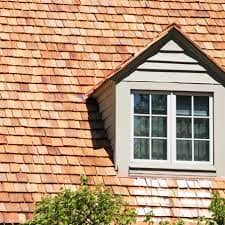
Historically, asphalt shingles, slate, clay, and concrete tiles were almost the only roofing materials available. Modern roofing materials provide an unparalleled variety of options, as well as new aesthetics for traditional materials.
There are a variety of roofing materials to pick from, and a little research may lead you to explore a different material rather than just replacing the one you already have. Choosing the proper roofing material needs consideration of aesthetics, durability, cost, and structural concerns.
Things To Consider For Choosing the roofing materials
Architectural and Three-Tab
Architectural asphalt shingles are thicker than three-tab shingles and produce a layered, lasting appearance on the roof. Architectural shingles are more costly due to their superior material and installation time.
However, they may survive between 15 and 30 years and are more resistant to the elements. Asphalt shingles with three tabs are thinner and carved to resemble three shingles.
This expedites the installation process and produces a consistent, brick-like pattern. They are susceptible to severe winds and typically last between 7 and 15 years. This is often the least expensive roofing choice.
Metal Roofing
Metal roofing seems to be a contemporary option, although it has been available since the 1800s. The most common metal roofing material is prepainted galvanized steel, which has corrosion-resistant properties due to the paint on the surface. Metal sheets and shingles also continue to be a popular option since aluminum and zinc are inexpensive, lightweight, low-maintenance, and attractive even as they age.
They may endure up to eighty years and range in price from $6 to $14 per square foot, depending on their design and composition. Londonecometal is the best place to purchase metal roofing.
There are two options available: shingles and sheets (also known as panels) with a “standing seam” connection. The metal may also be pre-treated using sealants. While metal roofing is available in a range of hues, some types may also be painted.
Stone-coated steel
Interlocking panels resemble slate, clay, or shingles and are resistant to damage from high rainfall (up to 8.8 inches per hour), winds of 120 miles per hour, uplift, hail, and freeze-thaw cycles.
Therefore, they are a cheap and efficient option for damp, windy, or wildfire-prone environments. Certain stone-coated steel roofs come with a lifetime warranty.
Built-up roofing
This heavy roofing material comprises asphalt, tar, or adhesive layers covered with aggregate and is reserved for flat roofs only. Tar and gravel roofs, which are also suitable for flat roofs, are ideal for heavily traveled roof decks.
These roofs may grow sticky in the summer and are more difficult to remove snow from than smooth surfaces. They have a 20 to 25-year lifespan.
The ideal kind of roof for your environment, budget, and home will rely on these factors. To choose the finest roofing material to utilize in your location, consult professional roofing contractors and examine surrounding newer projects for inspiration.
Slate
Slate roofing may survive for more than a century. It is noncombustible, waterproof, and resistant to mold and fungus. Slate is useful in damp conditions, but it is costly, heavy, and quickly damaged when trodden upon. Consider this if you reside in a region that suffers hail.
Composite Asphalt Shingles
In North America, asphalt composite shingles are the most used roofing material. Made with a fiberglass base with asphalt and mineral granules, these three-tab shingles are an excellent option for the majority of residential roofing requirements.
They normally come with a 20- to a 30-year guarantee, and repairing broken shingles is a rather simple process. Almost every roofing firm has experience installing these singles. Composite shingles excel in bending and adapting to the expansion and contraction of a roof.
Green Roofing
Green roofs (or living roofs) are composed of pollinator-friendly plants such as grasses and native wildflowers. They cost between $10 and $25 per square foot to install and have several advantages, including minimizing rainwater runoff and mitigating excessive heat outside the house. Typically, green roofs survive 30 to 50 years.
Wood Shakes or Shingles
Wooden roofs are quite appealing, but they are pricey and have some limits. They have a short lifespan and should not be planted in regions where there is a high risk of flooding or wildfires.
Nevertheless, they are among the most aesthetically pleasing roofing materials, making them a popular option for luxury residences. Although both wood shakes and shingles are constructed from natural wood, often cedar or redwood, there is a distinction between the two.
Shingles are generally thin, wedge-shaped wood slabs that are cut with precision. Shakes are formed by slicing wood into thicker wedges with a coarser surface.
Shakes are more costly than shingles, with average prices ranging from $6.50 to $14 per square foot for installation. The length of one’s life is highly dependent on their environment and care. In reasonably dry regions, a wood shingle or shake roof may last up to 60 years, but in wet climates, it may only last 20 to 30 years.
Rubber slate
Rubber slate has a natural appearance and may be cut with a knife to suit complicated Victorian-era roofs. Rubber slate roofs may endure up to a century, but they can be damaged by satellite dishes and foot traffic, therefore they may also be subject to hail damage like slate. It may be difficult to locate roofing specialists that are qualified to install rubber slates.